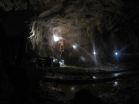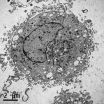Ancient, hydrogen-rich waters discovered deep underground at locations around the world
A quantum change in our understanding of how much of Earth's crust may be habitable
2014-12-17
(Press-News.org) A team of scientists, led by the University of Toronto's Barbara Sherwood Lollar, has mapped the location of hydrogen-rich waters found trapped kilometres beneath Earth's surface in rock fractures in Canada, South Africa and Scandinavia.
Common in Precambrian Shield rocks - the oldest rocks on Earth - the ancient waters have a chemistry similar to that found near deep sea vents, suggesting these waters can support microbes living in isolation from the surface.
The study, to be published in Nature on December 18, includes data from 19 different mine sites that were explored by Sherwood Lollar, a geoscientist at U of T's Department of Earth Sciences, U of T senior research associate Georges Lacrampe-Couloume, and colleagues at Oxford and Princeton universities.
The scientists also explain how two chemical reactions combine to produce substantial quantities of hydrogen, doubling estimates of global production from these processes which had previously been based only on hydrogen coming out of the ocean floor.
"This represents a quantum change in our understanding of the total volume of Earth's crust that may be habitable," said Sherwood Lollar.
"Until now, none of the estimates of global hydrogen production sustaining deep microbial populations had included a contribution from the ancient continents. Since Precambrian rocks make up more than 70 per cent of the surface of Earth's crust, Sherwood Lollar likens these terrains to a "sleeping giant", a huge area that has now been discovered to be a source of possible energy for life," she said.
One process, known as radiolytic decomposition of water, involves water undergoing a breakdown into hydrogen when exposed to radiation. The other is a chemical reaction called serpentization, a mineral alteration reaction that is common in such ancient rocks.
This study has important implications for the search for deep microbial life. Quantifying the global hydrogen budget is key to understanding the amount of the Earth's biomass that is in the subsurface, as many deep ecosystems contain chemolithotrophic - so-called "rock-eating" - organisms that consume hydrogen. In the deep gold mines of South Africa, and under the sea, at hydrothermal vents where breaks in the fissure of Earth's surface that release geothermally heated waters - hydrogen-rich fluids host complex microbial communities that are nurtured by the chemicals dissolved in the fluids. This study identifies a global network of sites with hydrogen-rich waters that will be targeted for exploration for deep life over the coming years.
Further, because Mars - like the Precambrian crust - consists of billions-of-year-old rocks with hydrogen-producing potential, this finding has ramifications for astrobiology. "If the ancient rocks of Earth are producing this much hydrogen, it may be that similar processes are taking place on Mars," said Sherwood Lollar.
INFORMATION:
Other key members of the research team are Chris Ballentine of Oxford University, Tulis Onstott at Princeton University and Georges Lacrampe-Couloume of the University of Toronto. The research was funded by the Canada Research Chairs program, the Natural Sciences & Engineering Research Council, the Sloan Foundation Deep Carbon Observatory, the Canadian Space Agency and the National Science Foundation.
IMAGES and Nature paper: uoft.me/ancient
MEDIA CONTACTS:
Barbara Sherwood Lollar
Department of Earth Sciences
University of Toronto
416-978-0770
bslollar@chem.utoronto.ca
Kim Luke
Communications, Faculty of Arts & Science
University of Toronto
416-978-4352
Kim.luke@utoronto.ca
[Attachments] See images for this press release:

ELSE PRESS RELEASES FROM THIS DATE:
2014-12-17
Chemical modifications to DNA's packaging -- known as epigenetic changes -- can activate or repress genes involved in autism spectrum disorders (ASDs) and early brain development, according to a new study to be published in the journal Nature on Dec. 18.
Biochemists from NYU Langone Medical Center found that these epigenetic changes in mice and laboratory experiments remove the blocking mechanism of a protein complex long known for gene suppression, and transitions the complex to a gene activating role instead.
Researchers say their findings represent the first link ...
2014-12-17
LA JOLLA, CA--December 17, 2014--Chemists at The Scripps Research Institute (TSRI) have invented a powerful method for joining complex organic molecules that is extraordinarily robust and can be used to make pharmaceuticals, fabrics, dyes, plastics and other materials previously inaccessible to chemists.
"We are rewriting the rules for how one thinks about the reactivity of basic organic building blocks, and in doing so we're allowing chemists to venture where none has gone before," said Phil S. Baran, the Darlene Shiley Chair in Chemistry at TSRI, whose laboratory reports ...
2014-12-17
Johns Hopkins and University of Alberta researchers have identified a single protein as the root of painful and dangerous allergic reactions to a range of medications and other substances. If a new drug can be found that targets the problematic protein, they say, it could help smooth treatment for patients with conditions ranging from prostate cancer to diabetes to HIV. Their results appear in the journal Nature on Dec. 17.
Previous studies traced reactions such as pain, itching and rashes at the injection sites of many drugs to part of the immune system known as mast ...
2014-12-17
Researchers found 53 existing drugs that may keep the Ebola virus from entering human cells, a key step in the process of infection, according to a study led by researchers at the Icahn School of Medicine at Mount Sinai and the National Institutes of Health (NIH), and published today in the Nature Press journal Emerging Microbes and Infections.
Among the better known drug types shown to hinder infection by an Ebola virus model: several cancer drugs, antihistamines and antibiotics. Among the most effective at keeping the virus out of human cells were microtubule inhibitors ...
2014-12-17
Researchers from Intermountain Medical Center in Salt Lake City have identified a new "sliding scale" model used to rule out potentially deadly blood clots in the lungs, known as pulmonary embolisms, that is more accurate than current diagnostic methods.
The new model, which factors in a patient's age, more accurately identifies a patient's risk of the often-deadly blood clots and can more easily rule out the need for additional, more invasive tests, helping to reduce unnecessary costs.
The research is published in the medical journal, CHEST.
Pulmonary embolism is ...
2014-12-17
The engineered spring flood that brought water to previously dry reaches of the lower Colorado River and its delta resulted in greener vegetation, the germination of new vegetation along the river and a temporary rise in the water table, according to new results from the binational team of scientists studying the water's effects.
The experimental pulse flow of water was the result of a U.S.-Mexico agreement called Minute 319.
"The pulse flow worked," said Karl W. Flessa, co-chief scientist for the Minute 319 Science Team. "A small amount of water can have a big effect ...
2014-12-17
New research helps explain a paradoxical effect of certain antidepressants--that they may actually worsen symptoms before helping patients feel better. The findings, highlighted in a paper publishing online December 17 in the Cell Press journal Trends in Cognitive Sciences, may help investigators fix the problem as well as create new classes of drugs to treat depression.
Selective serotonin reuptake inhibitors (SSRIs) are the most widely prescribed class of antidepressant drugs, and they work by increasing levels of a brain chemical called serotonin. While this boost ...
2014-12-17
In an article to be published in the January issue of BioScience, two philosophers tackle one of the most divisive arguments in modern biology: the value of the theory of "kin selection."
Kin selection is the idea that because genes influence behavior, and because an animal that helps its relatives helps to spread genes likely identical to its own, animals will evolve to favor kin. Researchers have spent decades testing this explanation for apparent animal altruism, but in recent years, critics, notably Martin Nowak of Harvard University and the famous naturalist and ...
2014-12-17
(PHILADELPHIA) - Researchers look to understand the causes of amyotrophic lateral sclerosis (ALS), in the hope of finding new ways to treat the disease. A new study published online today (December 17th) in the Cell Press journal Neuron shows that a common gene mutation in ALS generates a deadly protein that may cause the damage in the brain that leads to ALS.
About 5 percent of ALS patients carry an altered version of a gene called C9orf72, which in ALS patients contains hundreds of repeat sequences that otherwise are not present in normal individuals. Since the gene's ...
2014-12-17
When faced with making choices, but lack sufficient evidence to guarantee success, our brain uses elapsed time as a proxy for task difficulty to calculate how confident we should be, a team of neuroscientists has found. Their findings, which appear in the journal Neuron, help untangle the different factors that contribute to the decision-making process.
"In our daily lives, we make many decisions," says Roozbeh Kiani, an assistant professor in NYU's Center for Neural Science and one of the study's authors. "Sometimes the evidence afforded us is strong, enabling us to ...
LAST 30 PRESS RELEASES:
[Press-News.org] Ancient, hydrogen-rich waters discovered deep underground at locations around the world
A quantum change in our understanding of how much of Earth's crust may be habitable



